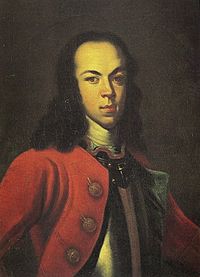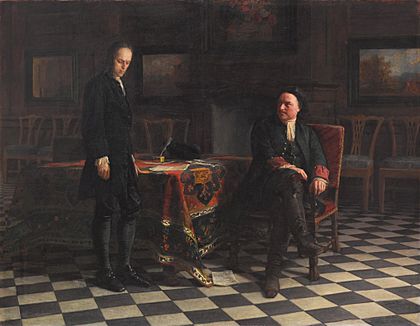Alexei Petrovich, Tsarevich of Russia facts for kids
Quick facts for kids Alexei Petrovich |
|
|---|---|
| Tsarevich of Russia | |

Portrait of Alexei by Johann Gottfried Tannauer, c. 1712–16, Russian Museum, Saint Petersburg
|
|
| Born | 28 February 1690 Moscow, Russia |
| Died | 26 June 1718 (aged 28) Petropavlovskaya fortress, St. Petersburg, Empire of Russia |
| Spouse |
Duchess Charlotte Christine of Brunswick-Wolfenbüttel
(m. 1711; died 1715) |
| Issue |
|
| House | Romanov |
| Father | Peter I of Russia |
| Mother | Eudoxia Lopukhina |
Alexei Petrovich (born 28 February 1690 – died 26 June 1718) was a Russian prince, known as a Tsarevich. He was the son of Tsar Peter I and his first wife, Eudoxia Lopukhina. Alexei and his father often had different ideas about Russia's future. Alexei's journey to Austria caused problems for the Russian government. Sadly, Alexei passed away after being questioned, and his younger half-brother, Peter Petrovich, became the next in line to the throne.
Contents
Early Life of Alexei Petrovich
Alexei grew up mostly with his mother. She did not get along with his father, Tsar Peter I. This made it hard for Alexei to feel close to his father.
From ages 6 to 9, Alexei had a tutor named Vyazemsky. After his mother was sent away by Peter the Great, Alexei was taught by foreign teachers. They taught him important subjects like history, geography, mathematics, and French.
Alexei's Education and Royal Duties
In 1703, Alexei was told to join the army as a private in an artillery group. In 1704, he was present when the city of Narva was captured. His teachers at this time thought he was very smart. Alexei was interested in old buildings and religious studies.
However, his father, Peter the Great, wanted Alexei to focus on helping Russia grow stronger. Peter expected him to work hard to keep Russia's new wealth and power. This led to many disagreements between father and son. Alexei also spent time with older Russian nobles and priests. Some of these people encouraged him to dislike his father.
Alexei's Marriage and Family
In 1708, Peter sent Alexei to Smolensk to gather supplies for the army. Then he went to Moscow to help make the city stronger against Charles XII of Sweden. In late 1709, Alexei went to Dresden, Germany, for a year. There, he continued his lessons in French, German, math, and building defenses.
After his studies, Alexei married Princess Charlotte of Brunswick-Wolfenbüttel. Her family was connected to many important European royal families. For example, Charlotte's sister Elizabeth was married to Holy Roman Emperor Charles VI. Alexei and Charlotte met and were happy with each other, so the marriage went ahead.
The marriage agreement was signed in September 1711. The wedding took place in Torgau, Germany, on 14 October 1711. One part of the agreement was that any children they had would be raised in the Orthodox faith. However, Charlotte herself was allowed to keep her Protestant faith. Some of Alexei's supporters did not like this part of the agreement.
At first, the marriage seemed to go well. But after about six months, it became difficult. Alexei started to live in separate rooms and often ignored Charlotte in public.
Soon after the wedding, Alexei was sent by his father to Toruń to help provide food for Russian troops. For the next year, Alexei was constantly traveling. His wife joined him in Toruń in December. But in April 1712, he was ordered to join the army in Pomerania. Later that year, he had to go with his father on a trip to Finland.
Alexei and Charlotte had two children:
- Natalia Alexeievna Romanova (born 21 July 1714 – died 3 December 1728)
- Peter Alexeyevich Romanov (born 23 October 1715 – died 30 January 1730)
Their son, Peter Alexeyevich, later became Emperor Peter II in 1727. When he passed away in 1730, the direct male line of the Romanov family ended.
After Natalia was born in 1714, Alexei brought his long-time companion, Afrosinia, to live in the palace. Some historians believe that Alexei's conservative supporters did not approve of his foreign wife. This might have been why he treated Charlotte poorly. Another person who influenced Alexei was Alexander Kikin, a high-ranking official who had problems with the Tsar.
Alexei's Escape and Return
After returning from Finland, Alexei was sent by his father to Staraya Russa and Lake Ladoga. His task was to oversee the building of new ships. This was the last assignment his father gave him, as Peter was not happy with Alexei's work or his lack of interest.
Peter the Great made one last effort to connect with his son. On 22 October 1715, Charlotte died after giving birth to their son, Peter. On the day of the funeral, Peter sent Alexei a serious letter. He urged Alexei to take more interest in state affairs. Peter threatened to remove Alexei from the line of succession if he did not follow his father's plans. Alexei wrote back, offering to give up his right to the throne in favor of his baby son, Peter. Peter agreed, but only if Alexei would become a monk. This would mean he could no longer be a threat to the throne.
While Alexei thought about what to do, Peter wrote to him again on 26 August 1716. Peter was abroad with the army and told Alexei to join him if he wanted to remain Tsarevich. Instead of facing his father, Alexei fled to Vienna. He sought protection from his brother-in-law, Emperor Charles VI. The Emperor sent him for safety to the Ehrenberg fortress in Tirol and then to the castle of Sant'Elmo in Naples. Afrosinia went with him on his journey.
The Emperor truly felt for Alexei and thought Peter might have harmful intentions toward his son. This is clear from a private letter he sent to George I of Great Britain, asking for advice. Peter felt insulted by Alexei's flight. A prince running to a foreign ruler was a public shame. Peter decided Alexei had to be brought back to Russia at any cost. Count Peter Tolstoi, one of Peter's cleverest servants, was given this difficult job.

Alexei agreed to return only if his father promised not to punish him. He wanted to be treated like a son and allowed to live peacefully on his estates and marry Afrosinia.
On 31 January 1718, Alexei arrived in Moscow. Peter had already decided to investigate the reasons for his son's flight. On 18 February, Alexei gave a statement that involved many of his friends. He then publicly gave up his right to the throne in favor of his young son, Peter Alexeyevich.
More statements were taken from Alexei in April 1718, including words from Afrosinia, who had shared what she knew.
Even with these statements, there was not much direct proof against Alexei. The most serious accusation was that he had wished for his father's death. In Peter's view, his son was now a dangerous person who had betrayed him. However, Peter had promised to forgive Alexei and let him live in peace if he returned.
The whole situation was presented to a large council on 13 June 1718. This council included religious leaders, senators, government officials, and other important people. The clergy said it was a matter for the government, not the church, and left the decision to the Tsar.
On 24 June, the 126 members of the Senate and court declared Alexei guilty. They sentenced him to death. On 26 June, Alexei passed away in the Peter and Paul fortress in Saint Petersburg. This was two days after the court had sentenced him.
Alexei's Family Tree
| Ancestors of Alexei Petrovich, Tsarevich of Russia | |||||||||||||||||||||||||||||||||||||||||||||||||||||||||||||||||||||||||||||||||||||||||||||||||||||||||||||||||||||||||||||||||||||||||||||||||||||||||||||||||||||||||||||||||||||||||||||||||||||||||||||||||||||||||||||||||||||||||||||||||||||||||||||||||||||||||
|---|---|---|---|---|---|---|---|---|---|---|---|---|---|---|---|---|---|---|---|---|---|---|---|---|---|---|---|---|---|---|---|---|---|---|---|---|---|---|---|---|---|---|---|---|---|---|---|---|---|---|---|---|---|---|---|---|---|---|---|---|---|---|---|---|---|---|---|---|---|---|---|---|---|---|---|---|---|---|---|---|---|---|---|---|---|---|---|---|---|---|---|---|---|---|---|---|---|---|---|---|---|---|---|---|---|---|---|---|---|---|---|---|---|---|---|---|---|---|---|---|---|---|---|---|---|---|---|---|---|---|---|---|---|---|---|---|---|---|---|---|---|---|---|---|---|---|---|---|---|---|---|---|---|---|---|---|---|---|---|---|---|---|---|---|---|---|---|---|---|---|---|---|---|---|---|---|---|---|---|---|---|---|---|---|---|---|---|---|---|---|---|---|---|---|---|---|---|---|---|---|---|---|---|---|---|---|---|---|---|---|---|---|---|---|---|---|---|---|---|---|---|---|---|---|---|---|---|---|---|---|---|---|---|---|---|---|---|---|---|---|---|---|---|---|---|---|---|---|---|---|---|---|---|---|---|---|---|---|---|---|---|---|---|---|---|
|
|||||||||||||||||||||||||||||||||||||||||||||||||||||||||||||||||||||||||||||||||||||||||||||||||||||||||||||||||||||||||||||||||||||||||||||||||||||||||||||||||||||||||||||||||||||||||||||||||||||||||||||||||||||||||||||||||||||||||||||||||||||||||||||||||||||||||
See also
 In Spanish: Alejo Petróvich Románov para niños
In Spanish: Alejo Petróvich Románov para niños



